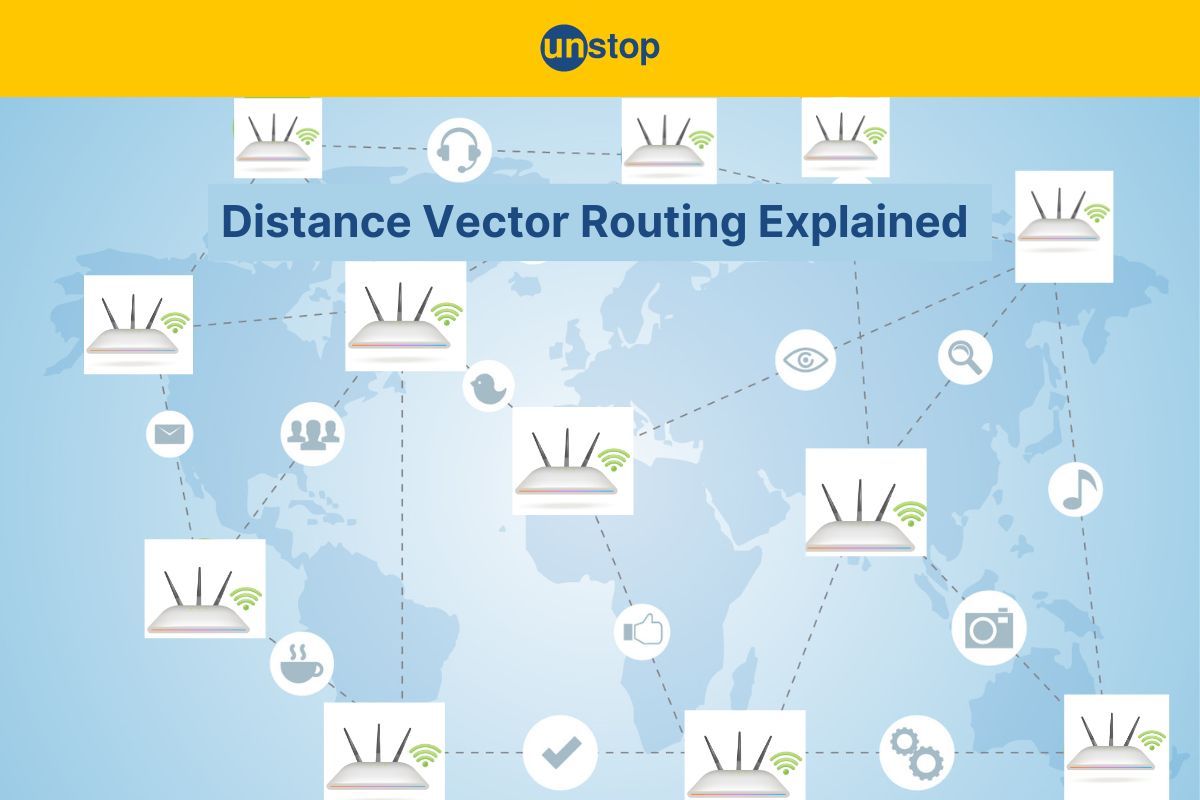- DVR Protocol & Working Mechanism
- Advantages Of Distance Vector Routing
- Disadvantages Of Distance Vector Routing
- Applications Of Distance Vector Routing
- Implementing A Routing Table With DVR
- Count To Infinity Problem & Solutions
- Overview Of The DVR Algorithm
- DVR Vs. Link State Routing Protocols
- Frequently Asked Questions (FAQs)
- Master Your Skills: Quiz Time
Distance Vector Routing | DVR Protocol & Algorithm Explained

Distance vector routing plays a crucial role in network protocols by allowing routers to exchange information in order to determine the most efficient paths for data transmission. By checking hop counts and updating route tables regularly, networks can run smoothly.
DVR Protocol & Working Mechanism
Distance vector routing (DVR) is a protocol in computer networks that guides data packets based on distance and direction. DVR operates by each router sharing its network knowledge with neighbors, who do the same until all routers have consistent information.
This way, every router knows about available paths and can choose the best one for packet transmission.
Periodic Updates
Distance vector routing (DVR) protocols rely on periodic updates to share routing information among neighboring routers. Each router maintains its own routing table, detailing the optimal path to various destinations.
These periodic updates ensure that routers have up-to-date information about network changes. Periodic updates in DVR protocols can help ensure network stability by promptly reflecting any modifications in the topology.

For example, if a link goes down, routers will update their routing tables during the next periodic update cycle, allowing them to adapt and reroute traffic efficiently.
Routing Table Updates
In DVR protocols, when a change occurs in the network—such as a link failure or new connection—routers immediately update their routing tables with this new information. Subsequently, they inform their neighbors about these changes through additional updates.
This iterative process continues until all routers have consistent routing information. The advantage of this mechanism is that it enables quick convergence within the network after any alterations occur.
By disseminating updated routing information across neighboring routers, distance vector routing ensures that all the computer devices are aware of changes and can adjust their paths accordingly.
Advantages Of Distance Vector Routing
Let us study the advantages of distance vector routing:
Simple Implementation
Distance vector routing (DVR) protocols stand out for their simplicity and ease of implementation, especially in small networks. Their straightforward nature makes them ideal for setups where complexity is not required.
For instance, a small office network with a handful of devices can benefit from the uncomplicated design of DVR protocols.
DVR protocols demand lower processing power and memory resources than more intricate routing protocols. This efficiency allows devices within the network to operate smoothly without being overwhelmed by excessive computational requirements.
As a result, networks running DVR protocols can function optimally without experiencing performance bottlenecks due to resource limitations.
Resistance To Network Congestion
Another key advantage of distance vector routing is its inherent resilience against network congestion. Since these protocols are decentralized, they can effectively navigate around congested areas by selecting less congested paths dynamically.
This adaptability ensures that data packets can flow through the network efficiently, even during peak usage times when congestion is more likely to occur.
Disadvantages Of Distance Vector Routing
Let us also study some of the disadvantages of distance vector routing:
Slower Convergence Time
Distance vector routing (DVR) protocols exhibit slower convergence times compared to link-state routing protocols. This delay in updating routing tables can lead to outdated information being used for forwarding data packets, impacting network efficiency.
Count To Infinity Problem
One significant issue with DVR protocols is the "count to infinity" problem. This occurs when incorrect routing information causes loops in the network, leading to data packets circulating endlessly without reaching their intended destination.
Ignoring Network Factors
Another drawback of distance vector routing is its failure to consider crucial factors like bandwidth or network load when determining routes. By overlooking these elements, DVR protocols may not always choose the most efficient paths for data transmission.
Applications Of Distance Vector Routing
Let us study some of the applications of distance vector routing in computer networks:
Small-Scale Networks
Distance vector routing (DVR) protocols find common usage in small-scale networks like home or office setups. These networks benefit from routing information being exchanged between neighboring routers, aiding in efficient data transfer.
Limited Resource Networks
DVR protocols suit networks with limited resources, prioritizing simplicity and efficiency over complexity. DVR protocols perform effectively in scenarios where real-time data transmission is not crucial, such as non-demanding environments like small businesses or residential settings.
Implementing A Routing Table With DVR
Let us study how to implement a routing table with DVR:
Initial Assumptions
When implementing distance vector routing (DVR), each router starts by assuming it can directly reach all destinations. This assumption forms the basis of creating the routing table.
Initially, routers populate their local tables with direct connections to all known destinations. These entries represent paths that are assumed to be the best routes at first.
Updating Routing Tables
Routers continuously exchange information with neighboring routers, sharing details about reachable destinations and associated costs. Based on these updates, routers adjust their routing tables accordingly.
As routers receive new information from neighbors, they compare it with their existing data in the routing table. If a neighbor provides a more efficient path to a specific destination, the router updates its local table to reflect this better route.
Count To Infinity Problem & Solutions
Let us study the count-to-infinity problem and solutions:
Split Horizon Technique
Split horizon is a technique used in distance vector routing to prevent routers from advertising routes back to the neighbor they learned them from. This helps avoid the count-to-infinity problem by not allowing misleading information about paths.
Implementing a split-horizon means that when a router learns about a route from its neighbor, it does not advertise that route back to the same neighbor.
For example, if Router A learns that Router B is the best path to reach a destination, Router A will not inform Router B of this information again.
Poison Reverse Method
Poison reverse is another solution for the count-to-infinity issues in distance vector routing protocols. This method involves routers advertising an infinite metric (such as 16 hops) for routes back toward their source, preventing loops and incorrect path selections.
For instance, if Router A advertises a route through Router B but later finds out there's a better path through Router C, using poison reverse would make sure that any advertisement sent back towards Router B has an infinite metric associated with it.
Overview Of The DVR Algorithm
Let us go through the overview of the DVR algorithm:
Iterative Calculations
Distance vector routing (DVR) algorithms utilize iterative calculations to find the best path for each destination in a network.

These algorithms work by routers sharing information about their directly connected neighbors, allowing them to determine the shortest path to reach different destinations within the network.
Bellman-Ford Algorithm
The Bellman-Ford algorithm is commonly employed in DVR protocols to compute the shortest path based on distance vectors. This algorithm ensures that routers select the most efficient route by considering various paths and updating their routing tables accordingly.
Continuous Updates For Convergence
DVR algorithms continuously update routing tables until convergence is achieved. This process involves routers exchanging information about distances and adjusting their routes iteratively until all routers have consistent information and agree on the best paths throughout the network.
DVR Vs. Link State Routing Protocols
Let us study the comparison of DVR protocol and state routing protocol:
Network Topology Knowledge
Distance vector routing (DVR) protocols do not necessitate routers to possess full knowledge of the network topology, unlike link-state routing protocols. This means each router only knows about its neighboring nodes and the cost to reach them.
DVR protocols rely on periodic updates exchanged between neighboring nodes, leading to lower overhead compared to more frequent updates in link state routing protocols. As a result, DVR is more suitable for larger networks where reducing network traffic is crucial.
Convergence Speed & Route Accuracy
On the other hand, link-state routing protocols offer quicker convergence times as they update route information immediately upon changes in the network. They also provide more precise route calculations since routers know the network's topology.
Conclusion
In conclusion, the Distance Vector Routing (DVR) protocol offers both advantages and disadvantages in networking. Understanding its working mechanism, creating routing tables, and addressing the count-to-infinity problem is crucial for efficient network operations.
Frequently Asked Questions (FAQs)
1. What is the DVR Protocol?
The Distance Vector Routing (DVR) protocol is a type of routing algorithm used in computer networks. It finds the best way for data packets by looking at distance and direction and updates routing tables by sharing info with nearby routers.
2. How does the DVR Protocol work?
In DVR Protocol, routers exchange routing information with their directly connected neighbors at regular intervals. Each router maintains a table that lists available destinations and the cost to reach them. By comparing this information with neighbors, routers update their routing tables to find the shortest path.
3. What are some advantages of Distance Vector Routing?
Distance Vector Routing offers simplicity in implementation, low computational overhead, and efficiency in small to medium-sized networks. It also adapts well to dynamic network changes and requires less memory compared to other routing algorithms.
4. What are some disadvantages of Distance Vector Routing?
One major drawback of Distance Vector Routing is its slow convergence time when dealing with large networks or frequent topology changes. It suffers from the "count-to-infinity" problem, where incorrect route updates can lead to suboptimal paths or network instability.
5. When should one consider using Distance Vector Routing?
Distance Vector Routing works well for small networks that value simplicity and easy setup over scalability. It works well in scenarios where network changes occur infrequently, and there's no need for advanced features like traffic engineering or fast convergence times.
Master Your Skills: Quiz Time
Suggested reads:
- Future Of Job Report 2023: AI & Machine Learning Trends For The Next 5 Years
- Learn How ChatGPT For Machine Learning Works: A Beginner's Guide
- Understanding Cloud Computing Architecture
- What Is Cache Memory In Computer? Understand the Basics
- What is Flow Control in Computer Networks? Understand In Detail
Instinctively, I fall for nature, music, humor, reading, writing, listening, traveling, observing, learning, unlearning, friendship, exercise, etc., all these from the cradle to the grave- that's ME! It's my irrefutable belief in the uniqueness of all. I'll vehemently defend your right to be your best while I expect the same from you!
Login to continue reading
And access exclusive content, personalized recommendations, and career-boosting opportunities.
Subscribe
to our newsletter
















Comments
Add comment